The Office Messages feature is one of Elation's most widely used feature because of its ease of use and versatility. Office messages allows you to keep tabs on tasks that need to be completed and set reminders for yourself, your colleagues and your staff to follow up. Visibility amongst the entire practice will allow for quick, easy follow-up and ensures that nothing falls through the cracks.
Contents
The Office Message feature is an internal communication mechanism built into your EHR that allows you to communicate with all members of your practice who also have a log in to the EHR. Office messages are patient specific and can be accessed by anyone who has access to the patient's chart. Office messages are sorted into the requiring action queue of the person who is most recently responsible for follow up. Each person's requiring action queue can be viewed at any time and anyone can reply to an open office message thread.
Important Note: An enhanced version of the Office Message feature is gradually being released to all customers. Elation will notify you once the enhanced version is available for your practice. Reference the following article if you are using the enhanced Office Message feature:
The Office Message feature allows you to keep track of tasks that need to be completed by anyone in your office. You can also set reminders for yourself, your colleagues and your staff to follow up. Since Office Messages are visible by your entire practice, messages can be quickly and easily followed-up on to ensure that nothing falls through the cracks.
You can initiate a message from 3 different locations:
a) In the Practice Home page by clicking "Message"
b) In the grey navigation bar at the top of a patient's chart by click:

c) from a Report or Visit Note by clicking "Actions" >>> "Office Message":
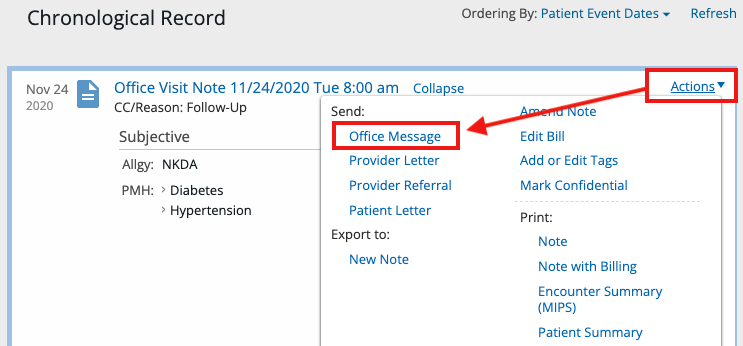
- User Tip: the Report, Visit Note or Note will be referenced in the Office Message to ensure accuracy
Next, compose your message:
- Enter the Patient's name in the Pt box (this is automatically populated if you initiated the message from the patient's chart)
- Search for and select recipients from the dropdown menu in the To box- choose individuals or try adding a User Groups!
- Compose your message in the Body box

User Tips
- The "Keep as Requiring Action" feature will keep an Office Message in your queue even if you may not be the one responsible for follow up. This feature allows you to keep all open message threads in your queue for easy access and visibility. For more information on this feature, please see the How is the "Keep as Requiring Action" box used? section of the FAQ.
- The "Mark as Urgent" box will also add the office message to the recipient's "Urgent" Practice Home inbox.
- Use the "Post Date" box to Post Date a Message Guide- Reminders & Task Follow Up to follow up on items at a specific time in the future.
Lastly, reply to any Office Messages in your Requiring Actions queue:
Click the "Reply" button to begin replying to open Office Message threads in your Requiring Actions queue.
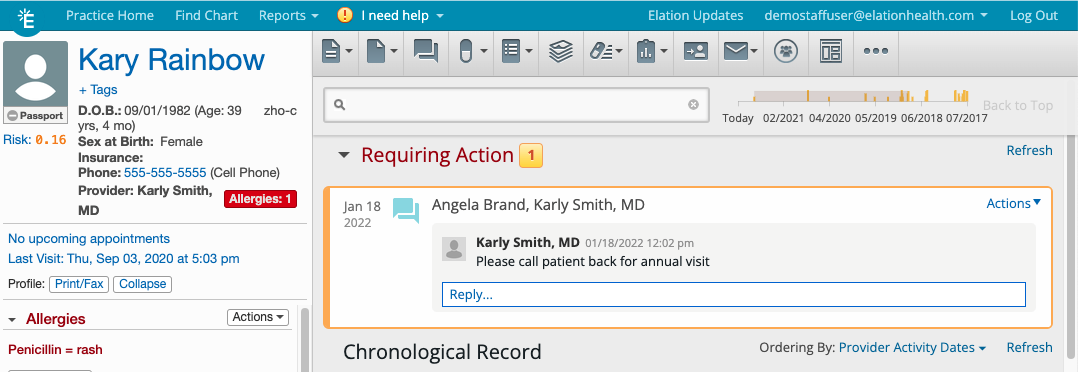
Practice Home:You can find your all your office messages (and those that you may monitor for others) within in the "Office Messages" queue on your Practice Home page. Any message in which you are responsible for follow up will be in this queue.

The Requiring Actions view in the Practice Home comes with a "View Queue For:" menu that will allow you to look at other colleagues'/staff member's Requiring Action items.
Patient Chart:
Any open office message in which you are responsible for follow up will be in the "Requiring Actions" box at the top of your Patient's chart. All other open office messages will be in the "Outstanding Items" box for other colleagues or providers to address.
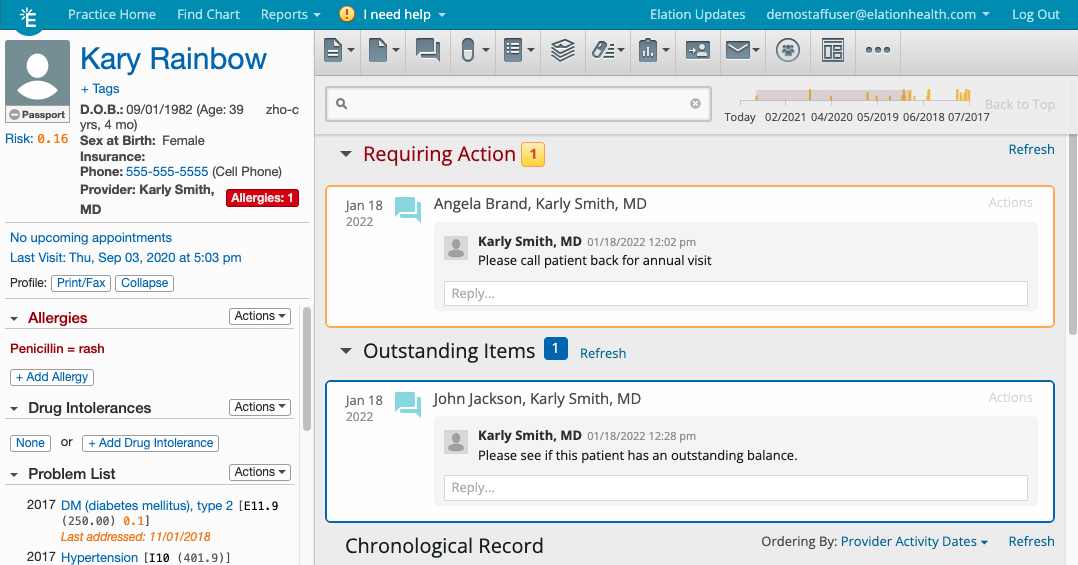
There are 3 message prompts for closing or completing office messages and office message threads. These include:
- Sign/Sign Off
- Only available for Provider Level Users.
- Acknowledge
- Available for Staff Level Users to acknowledge they saw a provider's message.
- Available for Provider Level Users to acknowledge that they saw a message that has been Signed Off by another provider.
- Acknowledge for Group
- Available for Staff Level Users and User Groups to acknowledge message threads. This will remove the message from all included user's queues when selected.
Important Notes:
- When a message is closed or a thread is completed, the message is removed from your queue, and will be filed into the patient chart for further reference.
- There are specific message behaviors between the various user account levels (provider and staff). These are detailed in the 'Special Message Behavior for Provider and Staff Level Users' section of this article.
This feature is only for Provider Level Users. When multiple Provider Level Users are participants in an office message thread, any Provider Level User can "Sign Off" on the office message. Signed messages will be stored in the Chronological Record section of the patient's chart.
When a Provider Level User sends an office message to Staff Level Users, Staff Level Users can only reply to the message (the option to "Acknowledge" is not available). The Provider Level User can sign off on the message thread once it is complete. Once the message is signed off by a Provider Level User, the Staff Level Users on the thread will need to "Acknowledge" the message to remove it from their Requiring Actions queue.
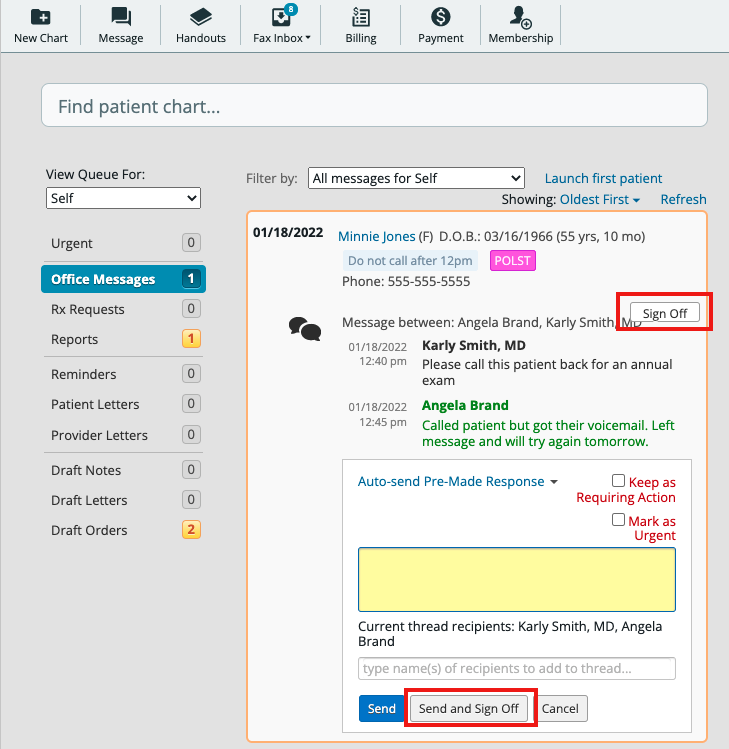
This feature ensures that all recipients (on an office message thread with Provider Level Users) view the final reply of the office message thread. Recipients must click "Acknowledge" after reading the latest replies to remove the office message thread from their Requiring Actions queue.
This feature is available for office messages between Staff Level Users, and User Groups. When a user clicks "Acknowledge for Group" the office message thread will be removed from all recipients Requiring Actions queue and stored in the Chronological Record section of the patient's chart. To keep the message in the queues for all users included on the thread, users should not click "Acknowledge for Group", and instead Staff Level Users will need to check "Keep as Requiring Action" for each reply.
Customers typically use the User Group functionality when only a single member of the group needs to address the message. For this reason, messages to User Groups have an “Acknowledge for Group” option to allow the person who addressed the message to click “Acknowledge for Group” to remove the message from everyone else’s queue. This workflow is the same regardless if "Keep as requiring action" is checked.
When an office message is sent to multiple individuals, instead of to a User Group, and "Keep as requiring action" is checked, each individual user must acknowledge the message for it to be removed from the queues.
The "Keep as Requiring Action" feature will keep an Office Message in your queue even if you may not be the one responsible for follow up. This feature allows you to keep all open message threads in your queue for easy access and visibility.
 The "Keep as Requiring Action"
The "Keep as Requiring Action" box is most commonly used for messages to more than one recipient because it will keep in message in all recipient's requiring action queues and not just the last responder.
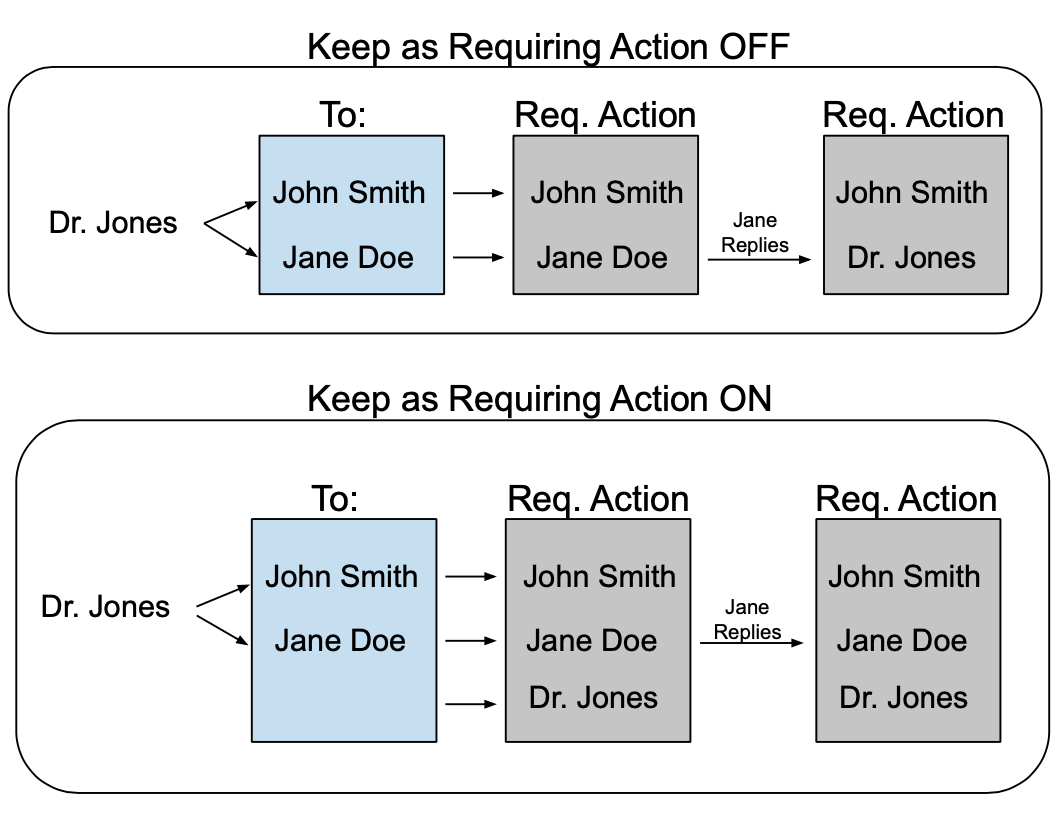
Provider Level Users have the option to “Sign/Sign Off” on office messages when they want to close out and finalize the message thread. They are also able to “Send and Sign Off” on messages that they want to reply to and finalize in one single action. When a message is signed off by a Provider Level User, every Provider Level Users on the thread will need to “Acknowledge” the message to remove it from their queues.
Important Note: When a message is closed or a thread is completed, the message is removed from your queue, and will be filed into the patient chart for further reference.
Provider Level Users sending messages to multiple providers
The behavior of sending messages between Provider Level Users will not differ if providers are sending messages to User Groups composed of only providers or if they are sending messages to multiple individual providers listed in the “To” field.
- All providers have the option to view the initial message before taking any subsequent action such as reply or sign off
- Every provider have the options to “Sign Off” or “Send and Sign Off” with a reply
“Keep as Requiring Action” Behavior
This behavior is consistent for both messages sent to User Groups and multiple individuals.
- Checkbox checked
- If “Keep as Requiring Action” is checked, then the message will stay in the sender’s queue as well as in the queues of the recipients
- If a provider checked “Keep as Requiring Action” on a message, but another provider Signs Off on the message, the message will appear in the queue of the provider who checked “Keep as Requiring Action” with the note “Signed by [Signing Provider’s name, date and time]”. The provider who checked “Keep as Requiring Action” will have the option to “Acknowledge” the message to remove it from their queue.
- Checkbox NOT checked
- If “Keep as Requiring Action” is NOT checked, then the message will only appear in the recipients' queues. Using “Sign Off” or “Send and Sign Off” will remove the message from all queues and is filed into the chart directly.
The behavior for office messages differs between sending messages to a User Group of Staff Level Users versus sending messages to multiple individual Staff Level Users that are listed in the "To" field. The key difference in behavior occurs when users reply to the message thread. The "Keep as Requiring Action" checkbox plays a helpful role in this behavior.
Important Note: When a message is closed or a thread is completed, the message is removed from your queue, and will be filed into the patient chart for further reference.
Staff Level Users sending to a User Group that consists of only Staff Level Users
- All users have the option to view the message before taking any subsequent actions such as replying or acknowledging
- Staff Level Users have the option to “Acknowledge for Group” on the original message which will remove the message from the everyone’s queue
“Keep as Requiring Action” Behavior
- Checkbox checked
- If the message needs to stay in everyone’s queues because all users need to see it and/or reply, each user must check the "Keep as Requiring Action" checkbox each time they reply to the thread.
- Checkbox NOT checked
- If “Keep as Requiring Action” is not checked, the message will be removed from the queue for all users once a single user replies. The intent of this behavior is to show that only one user from the User Group needs to take action on the message.
Staff Level Users sending to multiple individual staff members
- All users have the option to view the message before taking any subsequent actions such as replying or acknowledging
- Staff Level Users have the option to “Acknowledge for Group” on the original message which will remove the message from the everyone’s queue
“Keep as Requiring Action” Behavior
- Checkbox checked
- If the Staff Level User who sent the message wants to keep track of their message, they must check "Keep as Requiring Action" to keep the message in their queue.
- Checkbox NOT checked
- If the Staff Level user wants the message thread to appear in the queues of only other users on the thread, they can simply reply and do not need to check "Keep as Requiring Action".
Important Note: When a message is closed or a thread is completed, the message is removed from your queue, and will be filed into the patient chart for further reference.
Provider sending to User Group that includes Staff Level Users
- All users have the option to view the message before taking any subsequent actions such as replying or acknowledging
- Staff Level Users only have the option to reply at this stage. They will not have the options to “Acknowledge” or “Acknowledge for Group” until a Provider Level User has Signed Off on the message
- Provider Level Users have the option to
- “Sign Off” on the message thread to close the thread and remove the message from the queues of each member in the User Group.
- “Send and Sign Off” to reply and close the message thread with a single action. Using the option to “Send and Sign Off” will remove the message from the provider’s queue and close the thread from further replies from other users.
- Other users will have the option to “Acknowledge” the message thread, and remove it from their individual queue.
“Keep as Requiring Action” Behavior
- Checkbox checked
- If the user who replies on the thread would like to keep track of their message, they must check "Keep as Requiring Action" to keep the message in their queue.
- Checkbox NOT checked
- If the user wants the message thread to appear in only the queues of the other users on the thread, they can simply reply and do not need to check "Keep as Requiring Action".
Staff Level Users sending to a User Group that includes Provider Level Users
When a message is sent from a Staff Level User to a User Group that includes at least one Provider Level User, the following behavior can occur:
“Keep as Requiring Action” Behavior
- Checkbox checked
- If the user who replies wants to keep track of their message, they will need to check "Keep as Requiring Action" to keep the message in their queue.
- Checkbox NOT checked
- If the user wants the message thread to appear in the queues of the other users on the thread, they can simply reply and do not need to check "Keep as Requiring Action".
Important Note: As detailed
previously, the option to "Acknowledge for Group" is available for messages that are sent to User Groups or messages sent to multiple individual staff members listed in the "to" field. When this option is selected, it will remove the message from the queues of
all users on thread. Please reference the
Acknowledge and
Acknowledge for Group sections for more details about the differences between these two options.
- If a Provider Level User included in the User Group sends a message to the group, the Staff Level Users will only have the option to reply and the provider will sign off on the message when complete.
- If a Staff Level User included in the User Group sends the message to the group, Staff Level Users will have the option to "Acknowledge for Group" and Provider Level Users will have the option to “Sign off”.
This practice has three front office staff members and two MA’s. These staff are named Amber, Luke, and Paul. The MA’s are named Monica and Jacqueline.
User Group: Amber sends a message to the User Group, “All Staff”, which includes the front office staff and the MA’s. Amber details in the message that someone needs to add more paper to the printer. Paul replies stating that the office is out of printer paper and someone needs to order more. In his reply, Paul checked “Keep as Requiring Action” so that the message thread is not removed from the queues of those included in the User Group. Additionally, any subsequent replies that are not meant to finish and close the thread will need “Keep as Requiring Action” checked. However, if Paul replied to the thread detailing that he added the paper and did not check “Keep as Requiring Action”, the thread would be finished and removed from each person’s queue.
 Multiple Individual Staff Members:
Multiple Individual Staff Members:Amber sends a message to Luke and Paul detailing that they need to submit their timesheets for payroll and asks that they each reply once this is complete. To compose the message, Amber manually types in the names for Luke and Paul and checks “Keep as Requiring Action” so it stays in her queue. Luke replies, and the message is removed from Luke’s queue, and stays in the queues for Amber and Paul. Paul replies, and the message is removed from Paul’s queue, reappears in the queue for Luke, and stays in the queue for Amber. Now after seeing the confirmation replies from Luke and Paul, Amber can acknowledge the message for the group to remove it from all queues.
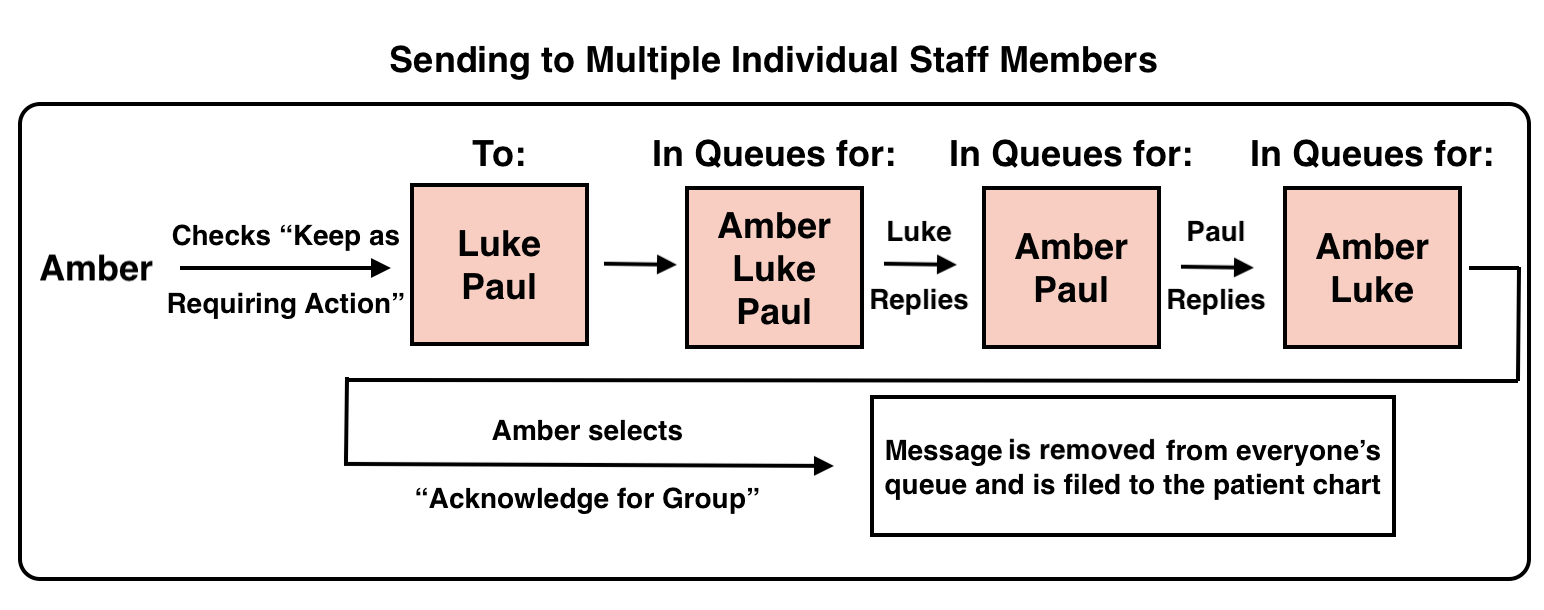
You can remove an Office Message by going into a patient's chart and clicking "Actions" >>> "Remove" at the top right corner of any office message thread.

Messages must be affiliated with a patient chart. Users can create a generic patient chart called "Inter-Office Messages Only" and then use that generic patient chart to send messages that are not patient-specific.
Yes, you can send a message to any combination of individuals by selecting their names from the "To" drop down and/or you can use our
user groups feature to group specific office members together. For example, I may send a message to all 5 medical assistants in my office by adding the 5 medical assistants to a user group called "Medical Assistants" and then selecting "Medical Assistants (Group)" from the "To" drop down..
Use the "type name(s) of recipients to add to thread..." box at the bottom of an open office message thread to search for a new recipient to add more recipients to the thread.
-
User Tip: Check off the "Keep as Requiring Action" box if you want existing members of the thread to continue to see the thread in their Requiring Action queue (ex. John Jackson). If you do not check off the "Keep as Requiring Action" box, then only the new recipients (Angela Brand) will see the new message in the Requiring Action queue.
Anyone can add themselves to an open office message thread by replying to the message. When this happens, the message will automatically appear in the Requiring Action queue of all prior recipients.
If you are viewing group queues (such as "Everyone", "All Provider" or "All Staff") from the Practice Home page, you may sometimes see that a closed office message thread that you have acknowledged is still visible in the queue. This is because ALL recipients of a messages must "acknowledge" the message for it to be completely removed from everyone's Requiring Action queue.
Check with the other recipients of the message to make sure they have clicked the "Acknowledge" button.
What is the Post Date box used for?Use the "Post Date" box to Post Date a Message Guide- Reminders & Task Follow Up to follow up on items at a specific time in the future. These can serve as reminders to take actions on specific dates or timeframes. Practices most commonly use this feature to remind themselves when patients are due for the next annual wellness exam.Can I add my own Office Message templates to Elation?
We currently do not have a feature for users to customize and/or add their own Office Message templates directly to Elation. You can add your own message templates to Elation by Using Templating Softwares with Elation.
When a message is sent to a User Group, the name of the original sender of the message will display in the “Message between” section along with the User Group name. This helps detail which user started the message thread. For more information on how to best use User Groups, please reference the article,
User Groups Guide- Simplifying office messages & expanded calendar view.

Next Step
Send a message to yourself or a staff member to start coordinating on tasks!
Related Articles



